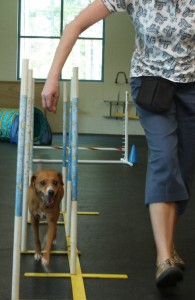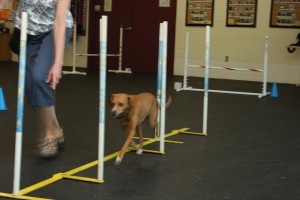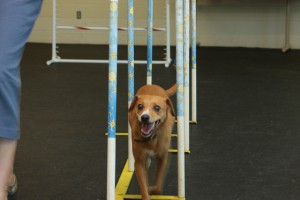
Learning anything complex takes time—don’t shortchange the process

As she gets familiar with the weave poles, my job is to guide her through with a treat but I think she’s more interested in watching our wonderful photographer friend, Annie Card. Thanks to Annie for all the pictures in today’s post!
One of the agility obstacles that Grace and I have not spent a lot of time with is the weave poles. When first learning this particular skill, the poles are “open” to create a channel that the dog walks through. Eventually, the goal is to have poles “closed” or set in a straight line so the dog then weaves around each pole in a zig-zag pattern. The most advanced dog will fly through as fast as they can – speed is required for winning agility dogs.
At a recent class, Grace did really well with these poles—considering how little we’ve worked with them. She readily goes in but she sometimes veers off in the middle or enters after the second pole instead of the first. There is also a standard for how you enter the poles and even I can’t remember if it’s right or left, so I’m fairly confident that Grace doesn’t remember that yet, either. We both have some learning to do.
The thing that amazes me about agility – and I believe it’s true about so many things—is how simple it can look on the surface but how complex it is to truly master it. Agility can provide a fun and non-competitive activity that has benefits of exercise along with mental stimulation. Yet it provides the opportunity for mastery of a complex craft; there is so much to know about the nuances of every move, yours and the dog. I’m starting to realize that it can take years to develop sufficient knowledge and efficient skills that encompass every single movement of your hand, the words you use, and the placement of your body. All of it (and most likely much more) determines the dog’s ability to perform.
In business, it seems we often don’t create this structured learning cycle. Because people have full plates and it is difficult to devote adequate time to training, employees are expected to perform at the highest level, immediately. Some managers provide the environment for risk-taking and mistakes, many do not. On-the-job training is valuable, but should be supported by strong mentoring and knowledgeable resources. If the learning process is rushed, incomplete or random, it can create so many issues, potentially ending in failure or blemishes on a person’s self-esteem.
When Grace goes through the weave poles right now, she thinks she’s a champion. She doesn’t even realize that we’ve only just begun. With each opportunity to build her confidence, we move to the next level. In agility, our instructor, Rachel works to make sure that the last experience for each dog on each piece of equipment is a positive one, so that they are excited to return for more. We need to stretch our physical and mental muscles, but we must also rest them, too, for the best learning.




She does look proud of herself. I have thought about starting the weave poles myself with Luna, before we even get into agility as it can be so difficult for some dogs to learn. I can’t wait till I can start some agility with her first. At this point in trying to get titles on her in other areas, I don’t even know if we will take it to competition level. That will depend on how we both take to it I guess. But I would love to do it with her simply for the mental workout. Do you plan to compete?
Anna
http://www.akginspiration.com
When I first started, I wasn’t even sure Grace and I would make it through the private lessons (I started her in that way to avoid any issues with other dogs or people, allowing her to focus on the agility, which did work out well). So when we “graduated” to a class with others, I felt we had really progressed. I have never intended to compete, but Rachel, the instructor, keeps saying, “You never know!”
She really does look proud and confidently happy. Way to go! Its nice to see grace so animated.
Thanks, Sara. It does make me happy to see Grace happy.
“When Grace goes through the weave poles right now, she thinks she’s a champion.” I love this line; it’s so revealing since it talks to how we “don’t know what we don’t know,” one of the key steps on the road to what Michael Polanyi calls Tacit Knowledge. An excellent human analogy is learning to ride a bicycle: we try, fall, try again, until our habits become internalized: we can’t tell anyone how we do it; we just know how. The converse is true, though, when we meet a professional racer, for example, who can give us tips and tricks on how to start a second wave of learning. Being aware that there’s always another wave, always more to learn, is vital. We structure the unstructured, then internalize it so that it again becomes unstructured, thereby completing the learning loop.
I believe most activities are more complex that they look, it depends who you’re watching performing them. The first example that comes to my head is related to my martial arts background. When I was training professionally, we had lots of kids and teenagers joining our dojo full of excitement, expecting to become Bruce Lee within a couple of weeks. Most of them dropped out when they realised the amount of work and boring repetition required to get to any level of proficiency. A lot of them said that we made it look easy…I took that as a compliment.
I’m sure it’s the same with agility. A well trained dog who enjoys the obstacles (like Gracie seems to in those photos) can make it look so easy that you won’t even think about the hours of training required to reach that level.
What these lovely photos show to me is not only that Grace enjoys agility, but also that she’s a wonderful mover. She’s got elegant, long strides, I think she’ll do well in competitions 🙂
Oh my, that’s a gentle nudge to competition. I’m still trying to find the courage for nail-cutting! 🙂 Isn’t it ironic that something that looks easy, like martial arts and agility along with a host of other things, actually is very difficult. I think it’s so true but equally fascinating to me.